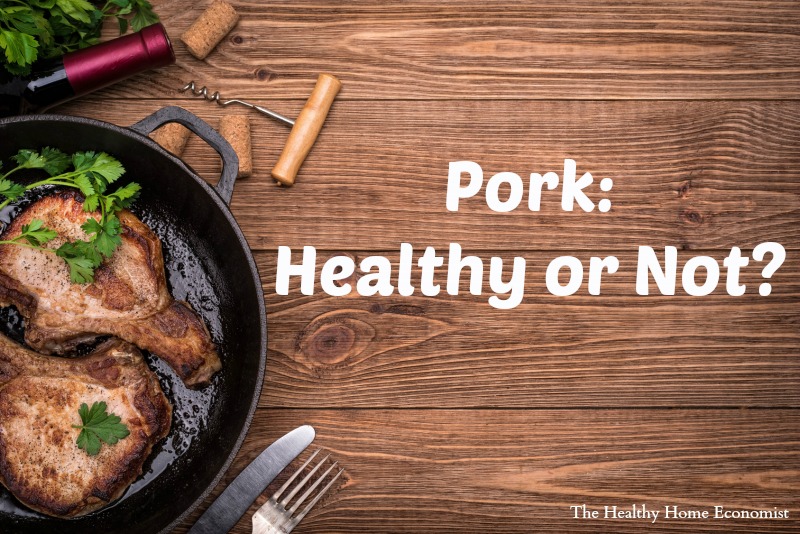Table of Contents[Hide][Show]

Pork is one of the most controversial meats on the planet. On one hand you have healthy ancestral cultures from the Middle East which forbid eating meat from pigs, deeming it unclean and unfit for human consumption.
On the other hand, Dr. Weston A. Price observed, photographed, and wrote about healthy traditional societies from the Polynesian islands that regularly consumed it. In addition, pork was and still is a major component of the diet of exceptionally long-lived cultures in Okinawa, Japan and the former Soviet republic of Georgia.
So what is the truth about pork, which comprises nearly 40% of the world’s current meat production? Is it healthy food to consume or not?
For those of us that love bacon, this is a very important question to consider!
Eating Freshly Cooked Pork Causes Undesirable Changes in the Blood
One compelling argument against the consumption of pig meat comes from practitioners who utilize live blood cell analysis in their offices. They observe that patients who eat fresh, cooked pork experience undesirable blood changes. These changes occur no matter whether the meat comes from pastured or conventionally raised pigs (1).
Ideally, red blood cells should be separate and uniformly round within the blood with no debris or clotting factors present.
Eating a meal of freshly cooked pork causes these free-floating red blood cells to become “sticky” within a few hours. The stickiness causes them to bind together in formations resembling stacks of coins or rouleaux. Worse, the condition triggers temporary disruption in the circulation of the blood. This occurs throughout all the microcapillaries and within organ tissues as well.
These tiniest capillaries are astoundingly small. Smaller even than the diameter of a single red blood cell! Thus, when they become entrapped in sticky formations, they simply cannot pass through. Reduced oxygenation of surrounding tissues is the result. It is no wonder that patients eating freshly cooked pork dishes frequently report fatigue. Reduced oxygenation capability within the blood would certainly trigger this symptom temporarily.
Considering this information alone, it seems logical to conclude that eating meat from pigs, pastured or not, is not a good idea!
But … Pork Consumed for Thousands of Years!
Given what live blood cell analysis tells us about eating pork, it may seem hard to believe that it helped nourish mankind for thousands of years. For example, the domestication of wild boar was first documented around 5000 BC.
Clearly, if eating “the other white meat” caused such dramatic and dangerous changes to red blood cells as described above, cultures that included it as a staple in the diet would not be healthy or enjoy such legendary longevity.
Something else must be at play.
That “something” is the extremely careful manner in which ancestral cultures that consumed pork actually prepared it. They didn’t just cook up chops on the grill like is commonly done today.
Traditional Preparation of Pork
Ancestral societies that ate pork knew either by instinct or observation that it required careful preparation first. In other words, it wasn’t a good idea to eat freshly cooked pork.
Here is a summary of traditional pork preparation techniques shared by the Weston A. Price Foundation:
- In the traditional Chinese diet, where the number one source of calories is pork and lard, the meat is typically cut up into small pieces and marinated in vinegar before cooking. When pork is prepared in this special way, it is considered healthy to eat. Pickled pork is another common dish. When not prepared traditionally, it is not considered fit for consumption.
- In Argentina and the Philippines, pork is also marinated in vinegar before cooking.
- European societies that consume pork traditionally ferment or cure it.
In Japan, it is common for the long-lived Okinawans to slowly stew their pork before eating. They also practice cutting up fresh pork meat into small pieces and marinating in Awamori, an Okinawan distilled liquor, fermented soy sauce, black sugar, herbs, and spices.
Live Blood Cell Analysis after Eating Traditionally Prepared Pork
As discussed above, live blood cell analysis demonstrates that consuming freshly cooked pork shows a significant negative effect on the blood. The red blood cells clump together in a manner that inhibits microcirculation. Note that consuming properly rendered lard is not a risk. It is the meat, not the pork fat, that is the problem.
What happens to the blood if traditionally prepared pork is consumed, however?
The same testing reveals that eating processed forms of pork such as bacon and prosciutto does not produce any blood coagulation or other visible changes in the blood five hours after eating. Similarly, consuming marinated cooked pork does not produce any blood coagulation or clotting.
You can view the pictures of sticky blood from eating fresh pork versus freely floating red blood cells in subjects who consumed traditionally cooked pork in this article by Beverly Rubik.
How to Prepare Pork Safely
Why does marinating, curing (as with bacon and ham), or fermenting pork somehow make it safe and healthy to eat?
Perhaps it has something to do with the fact that fresh pork meat is highly perishable. This is the case even when refrigerated. Have you ever noticed how much more quickly it tends to spoil than other types of meat in your fridge? Meat from hogs is also highly susceptible to parasites, most notably, Trichinella spiralis, a roundworm common worldwide.
Traditional preparation methods for pork accomplished three things:
- Preserved the meat from spoilage
- Eliminated risk of parasites
- Enhanced digestibility
Curing and Pickling
For example, using salts to cure pork kills parasitic cysts after twelve hours and inhibits the growth of pathogens to prevent spoilage of the meat (2). For these reasons, cured or pickled pork is far less likely to trigger food poisoning than fresh pork.
With regard to enhancing digestibility, it is important to note that often pork is smoked after curing. A subsequent aging process may also occur that naturally ferments the meat to add more flavor, enzymes and even probiotic properties.
Marinating
Marinating in an acidic liquid before cooking is another traditional method for preparing pork before cooking and eating. This is easily accomplished using vinegar or lemon juice. Soaking the fresh meat in an acidic medium while refrigerated ensures that it is unspoiled and safe for consumption. The process also eliminates any risk of parasites.
If you choose to consume meat sourced from pigs whether pastured or conventionally raised, marinating is the easiest way to prepare it before cooking to ensure it is safe and healthy to eat.
Below is an easy recipe for marinating chops. Hopefully, you are able to source them from pastured pigs!
What About Bacon?
There can be some confusion about what to do with bacon because many health food store brands are labeled “uncured”. The truth is that this bacon actually is cured, just not with conventionally added nitrates or nitrites. It is cured with celery juice or celery powder instead which is high in natural nitrates.
As a result, you do not have to marinate bacon as it is already cured and in some cases, also smoked.

Easy Marinated Pork Chops Recipe
Preparation of pork chops in a simple, traditional manner to ensure optimal digestibility.
Ingredients
- 4 pork chops preferably pastured
- 1/2 cup lemon juice
- 1/2 cup liquid whey
Instructions
-
Pound pork chops with a meat hammer. Mix lemon juice and whey together in a small bowl.
-
Place pork chops in a large glass bowl.
-
Pour whey and lemon juice over pork chops.
-
Leave uncovered in the refrigerator for at least one hour and up to 8 hours. Turn them once or twice during that time.
-
Dry pork chops thoroughly with paper towels or a clean dishtowel. No need to rinse, but you can if you like.
-
Cook as desired in the oven, on the grill, or a frypan on the stovetop.
-
Serve immediately and refrigerate any leftovers.
Recipe Notes
Lemon juice or other types of vinegar such as rice vinegar or white wine vinegar may be substituted for the apple cider vinegar. I do not recommend white distilled vinegar, as it is usually made from GMO corn.
Pork: Is it Safe to Eat?
In conclusion, choosing whether or not to eat meat from pigs is a very personal decision. If you choose to do so in your home, it is best to prepare the meat in a traditional manner, typically by marinating first. Slow cooking is another option such as the method used in this pork ribs recipe.
If purchasing prepared pork or ordering it at a restaurant, be sure it was cured, pickled, slow-cooked/smoked or aged/fermented first.
Other easy recipes to make from marinated pork are pastured meatballs, breakfast sausage, and Southern pulled pork.








Leave a Reply